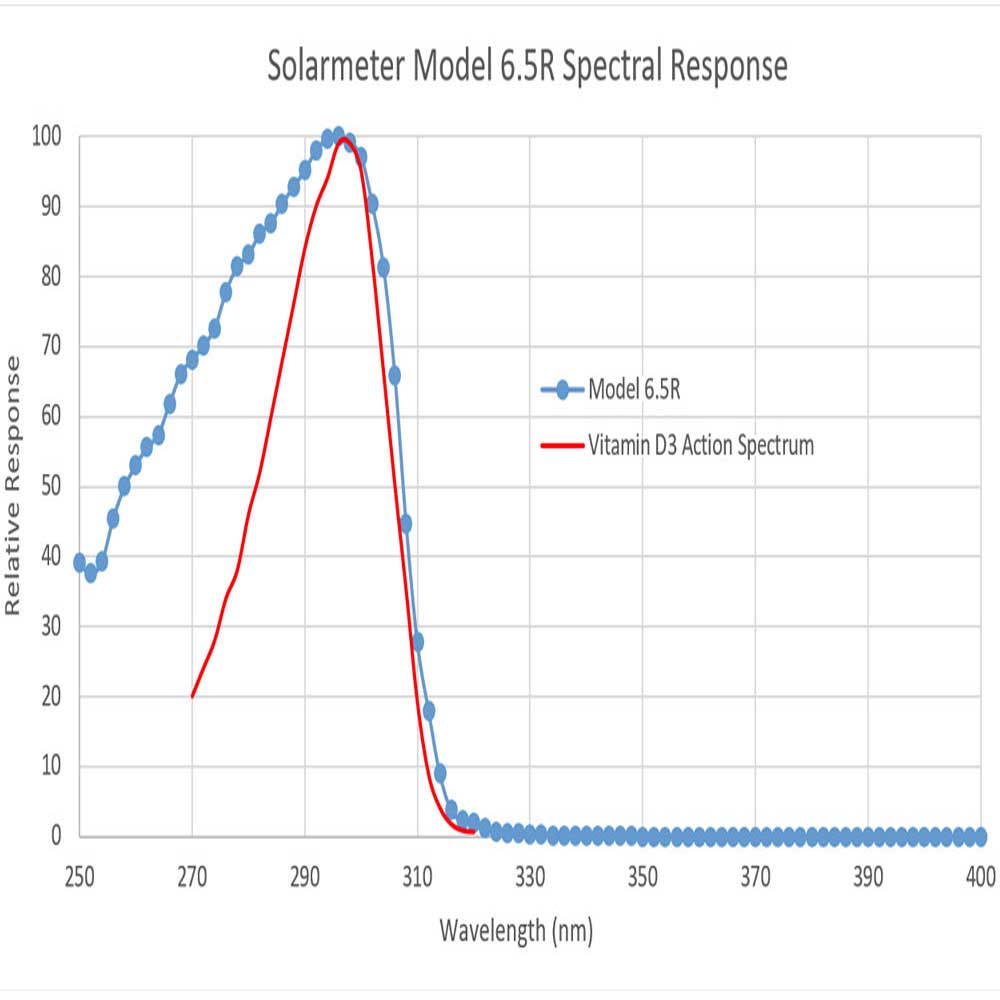- The Solarmeter® 6.5R Reptile UV Index measures UV Irradiance in the wavelengths that enable Vitamin D3 synthesis in reptiles.
- The current UV index is determined and can be monitored in the long term.
The measurement spectrum of the Solarmeter® 6.5R Reptile UV Index is very similar to the effective spectrum for vitamin D formation, which is why it is particularly useful for terrariums. Long-wave UVA and UVB radiation, which does not contribute to vitamin D formation and has a lower burning effect, is not perceived/measured in the process. The hand-held meter is therefore very capable of warning about lamps that either have too intense, short-wave radiation with a high risk of UV burns or do not emit enough vitamin D-effective radiation.
But which animal needs how much UVB to produce the right amount of vitamin D? The Ferguson Zones help answer this question.
| Ferguson Zone | Way of life | Species Include | UV Index Range | UV Index maximum |
|---|---|---|---|---|
| 1 | nocturnal, , crepuscular or Shade Dweller, Thermal Conformer | Crested Gecko Leopard Gecko Tokay Gecko Burmese Python Green Tree Python Milk Snake Reticulated Python | 0,0 – 0,7 | 0,6 – 1,4 |
| 2 | Partial Sun / Occasional Basker, Thermoregulator | Australian Water Dragon Emerald Tree Monitor Green Anole Monkey-Tailed Skink Pygmy Chameleon Ornate Box Turtle Red Foot Tortoise Boa Constrictor Red-Tailed Ratsnake Garter Snake Western Hognose Snake | 0,7 – 1,0 | 1,1 – 3,0 |
| 3 | Open or Partial Sun Basker, Thermoregulator | Black-and-White Tegu Frilled Lizard Standing’s Day Gecko Yemen Chameleon Indian Star Tortoise Leopard Tortoise Spotted Turtle Diamond Python | 1,0 – 2,6 | 2,9 – 7,4 |
| 4 | Mid-Day Sun Basker, Thermoregulator | Chuckwalla Uromastyx Rhinoceros Iguana Texas Horned Lizard | 2,6 – 3,5 | 4,5 – 9,5 |
What is a Ferguson Zone?
Using the original Solarmeter® Model 6.5 UV Index Meter, a team of herpetologists led by Professor Gary Ferguson of Texas Christian University published research in 2010, which summarized the daily UV exposure of 15 species of reptiles that were studied in the wild. These species were grouped into four zones, aka “Ferguson Zones,” according to their daily sun exposure requirements. In 2012, the British and Irish Association of Zoos and Aquariums (BIAZA) built on Ferguson’s research to produce a document allocating Ferguson Zones to 254 species of reptiles and amphibians.
| Model: | 6.5R |
| Irradiation Range: | 0-199.9 UV Index |
| Response: | 280-400 nm Diffey Erythemal Action Spectrum (closesly matches Vitamin-D Action Spectrum) |
| Resolution: | 0.1 UV Index |
| Conversion rate: | 3.0 Readings/Sec |
| Display: | 3.5 digit LCD |
| Digit Size: | 0.4 (in) / 10.2 (mm) high |
| Operational Temperature: | 32°F to 90°F / 0°C to 32.2°C |
| Operational Humidity: | 5% – 80% |
| Accuracy: | ±10% REF.NIST |
| Dimensions: | 4.2L x 2.4W x 0.9D (in) / 106.7L x 61W x 22.9(D) (mm) |
| Weight: | 4.5 oz / 128 g (including battery) |
| Power Source: | 9-Volt DC Battery |
| Lens: | UV Glas |
| Diffusor: | Teflon |

Operation:
To operate your Solarmeter®, aim the sensor window located on the top panel of the meter directly at a UV source. Press and hold the push-button switch on the face of the meter. For best results take note of the distance the reading was taken from the UV source in order to ensure repeatable results.
Battery operation voltage is viable from 9V down to 6.5V. Below 6.5V, the numbers on the LCD display will begin to dim, indicating the need for battery replacement. Under typical service load, a standard 9V battery will last approximately 2 years.
Proper Usage of Solarmeter® Ultraviolet Radiometer:
• Wear tinted eye wear when checking intense light sources. (Glasses that offer all-round protection are ideal.)
• Allow lights to warm-up prior to taking readings (at least 15 min).
• For best results take note of the distance the reading was taken from the UV source in order to ensure repeatable results.
• The lamps should be replaced when the performance drops to about 50 % of the original (new lamp) readings.
Maintenance and care:
• Do not expose the meter to extreme temperatures, humidity, shocks or dust. If the meter is accidentally exposed to extreme humidity or damp conditions, unusually high readings may occur. Allowing the meter to dry naturally or placing it in a bag of silicate will restore normal function.
• Use a very soft cloth to clean the meter. Keep the sensor free of oil, dirt, etc.



